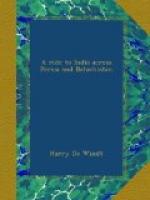A rough and tedious journey of two days over deep sandy desert, varied by an occasional salt marsh, brought us to Beila, the seat of government of the Djam, or chief of the province of Las Beila, eighty miles due north of Sonmiani. With a feeling of relief I sighted the dirty, dilapidated city, with its mud huts and tawdry pink and green banners surmounting the palace and fort. The Baluch camel is not the easiest animal in existence, and I had, for the first few hours of the march, experienced all the miseries of mal de mer brought on by a blazing sun and the rolling, unsteady gait of my ship of the desert. Though awkward in his paces, the Baluch camel is swift. They are small and better looking than most; nor do their coats present so much the appearance of a “doormat with the mange,” as those of the animals of other countries. We had as yet passed but two villages—three or four low shapeless huts, almost hidden in rock and scrub by the side of the caravan-track, which, as far as Beila, is pretty clearly defined. There had been nothing else to break the dull, dead monotony of sand and swamp, not a sign of human life, and but one well (at Outhal) of rather brackish water.
On the second day one of the escort had pointed out a dry rocky bed as the river Purali, which is one of the largest in Baluchistan, but, like all the others, quite dry the greater portion of the year. There are no permanent rivers in this country. To this fact is perhaps due the slight knowledge obtained up to the present time of the interior, where arid sandy deserts, dangerous alike to native or European travellers, are the rule, and cover those large open spaces marked upon maps as “unexplored.” Notwithstanding the great width of the bed of the Purali river in many places, it has no regular outlet into the sea. Its waters, when in flood from rainfall, lose themselves in the level plains in a chain of lagoons or swamps. Some of these are several miles in length, but decrease considerably in the dry season, when the water becomes salt. The Habb river, which divides Las from the British province of Sind, is another case in point. It possesses permanent banks, is fed from the Pabb chain of mountains, and after heavy rains in these hills a large body of water is formed, which rushes down to the sea with great force and velocity. But at other times water is only to be found in a few small pools in its rocky bed. It is, in short, a mountain torrent on a large scale. So also with the greater number of streams in the western districts, though a few of these have more the semblance of rivers than can be found elsewhere in Baluchistan. Of lakes there are none throughout the entire area of the country.
At Outhal we were met by one Hussein Khan, a wild-looking fellow mounted on a good-looking chestnut horse, its saddle and headstalls ornamented with bright-coloured leathers and gold and silver ornaments. Hussein was from Beila, with a message from the Djam to say that I was welcome in his dominions. Tents were then pitched, and I invited Hussein to partake of refreshment, which was refused. He accepted a cigarette, however, but seemed undecided whether to smoke or eat it, till presented with a light. Having asked if I would like to be saluted with guns on arrival, an offer I politely declined, my visitor then left to prepare for our reception on the morrow.




